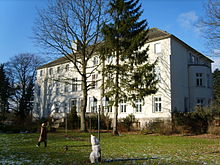Ranzin
Ranzin is a village (district) in the municipality of Züssow in the Vorpommern-Greifswald district . Ranzin can be reached via Kreisstraße 15, which runs from the B 111 (between Gribow and Thurow) and the B 109 near Klein Bünzow.
history
Ranzin was first mentioned in a document in 1228 as Villa "Randensyn". It was mentioned in a document about an exchange of territory between the Pomeranian Duke Barnim I and the Lübeck Cathedral Chapter. But Ranzin is a Slavic foundation, the name means something like 'wound', why is questionable.
The place is archaeologically verifiable (Bronze Age barrow), but the main settlement took place during the Slavic period, as some archaeological find areas to the northeast show.
The existence of a church has been documented since 1249. Evidently since at least 1315 - the tombstone of Michel Horn from that year in the church - Ranzin is the ancestral seat of the old Pomeranian noble family (von) Horn , who lived here for thirteen generations until 1845. The Horn´sche Gut Ranzin was directly connected to Oldenburg from the start. Matthias Magnus von Horn then had to sell the goods in 1751 because they could not be kept financially. After a short lease, it was sold to the bailiff PA Heydemann from Mecklenburg. After long trials up to the Wismar Tribunal , a son of the last owner named Bengt Gustav von Horn was able to reverse the sale in 1782.
Christian Leopold von Horn sold the goods Ranzin and Oldenburg in 1845 after renewed bankruptcy to the Wolgast shipowner and grain wholesaler Commerzienrat August Wilhelm Homeyer . In 1848 he laid out a Vorwerk Wilhelmshöh named after him , had the manor (castle) Ranzin built according to a design by the architect Richard Lucae , as well as many farm buildings. He and later his son Friedrich expanded the Ranzin estate into a model company. In 1864 the Homeyers were ennobled.
In 1865 Ranzin had 251 inhabitants, 1 church, 1 school, 19 residential houses, 5 factory buildings (including 1 mill, 1 distillery) and 22 farm buildings.
The village grew accordingly and in 1874 became the seat of the administrative district, to which the villages Oldenburg, Wilhelmshöh, Gribow, Glödenhof, Lüssow, Radlow, Züssow, Krebsow, Thurow and Nepzin belonged. It was not until 1935 that Ranzin had to give up the district seat in favor of Züssow.
The Homeyers remained in the possession until 1937, when the estate was inherited by the von Kameke family , who were the last owners of the estate. During the Second World War, numerous men from the Soviet Union had to do forced labor in the village . Four of them died during this time (1941–1942).
After the end of the Second World War , the Ranzin estate was expropriated, but not settled in the land reform because seed farms were excluded from the land reform. On September 26, 1945, the Ranzin estate was founded, which existed as VEG (seed breeding) and VEG (animal breeding) until the fall of the Berlin Wall . The castle became a boarding school for vocational training in the estate. After 1990 the two parts of the estate were privatized. In 1991 the Saka-Ragis Pflanzenzucht GbR Hamburg leased the estate and the seed breeding station.
With effect from January 1, 2005, the municipality of Ranzin gave up its independence and has been part of the municipality of Züssow since then. In March 2005, Ranzin had 229 inhabitants.
In 2009 Ranzin only had 200 inhabitants.
On December 31, 2014, Ranzin had 184 residents with a main residence and 20 with a secondary residence.
Attractions
-
Church Ranzin with
- Three tombstones of the von Horn family from 1315, 1357 and 1407. They are among the oldest preserved tombstones in Western Pomerania
- Exposed remains of wall paintings from the 14th century
- Half-timbered house in front of the church; oldest house in the village (probably end of the 15th century)
- Sexton's house from 1856
- Distillery called Villa Granito ; Factory building as a tall field stone building from before 1890, built for the landowner Friedrich von Homeyer
- Former sheepfold; Field stone construction with brick elements; with a round arch and stepped gable that protrudes over the flat roof. The terracotta medallions with rams' heads have been preserved on the gable of the current cowshed. Built for Friedrich von Homeyer in 1867 according to plans by Eduard Knoblauch (Berlin).
- Ranzin manor from 1877, successor to the manor house that burned down in 1875. The building was used as a hotel until 2017.
- Ranzin Tower Hill
literature
- Heinrich Berghaus : Land book of the Duchy of Pomerania and the Principality of Rügen, Part IV, Volume II, Anklam 1868, pp. 504 ff. And 600 ff.
- Manfred Niemeyer: East Western Pomerania. Collection of sources and literature on place names. Vol. 2: Mainland. (= Greifswald contributions to toponymy. Vol. 2), Ernst-Moritz-Arndt University of Greifswald, Institute for Slavic Studies, Greifswald 2001, ISBN 3-86006-149-6 .
Individual evidence
- ^ Manfred Niemeyer: Ostvorpommern. Collection of sources and literature on place names. Vol. 2: Mainland. (= Greifswald contributions to toponymy. Vol. 2), Ernst-Moritz-Arndt University Greifswald, Institute for Slavic Studies, Greifswald 2001, ISBN 3-86006-149-6 , p. 110
- ↑ StBA: Changes in the municipalities in Germany, see 2005
- ^ Züssow office, residents of the Züssow administrative area, as of December 31, 2014
Coordinates: 53 ° 57 ' N , 13 ° 32' E




